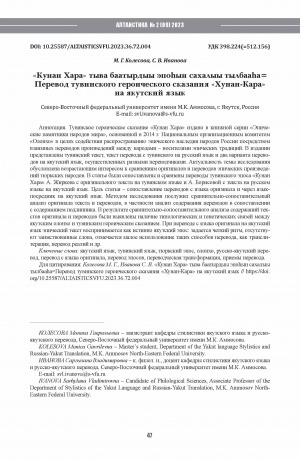Количество страниц: 13 с.
- Религия. Теология,
- Общественные науки. Образование > Этнография. Обычаи. Жизнь народа. Нравы,
- Искусство. Фотография. Музыка. Игры. Спорт > Музыка,
- НАУКА ЯКУТИИ > РЕЛИГИЯ. ТЕОЛОГИЯ,
- НАУКА ЯКУТИИ > ОБЩЕСТВЕННЫЕ НАУКИ > Этнография. Обычаи. Жизнь народа. Нравы,
- НАУКА ЯКУТИИ > ИСКУССТВО. ФОТОГРАФИЯ. МУЗЫКА. ИГРЫ. СПОРТ > Музыка.
Dobzhanskaya, O. E. Samoyedic shamanic drums: some symbolic interpretations / Oksana Dobzanskaya // Shamanhood and Mythology Archaic Techniques of Ecstasy and Current Techniques of Research : Honour of Mihály Hoppál, celebrating his 75th Birthday / edited by Attila Mátéffy, György Szabados, Tamás Csernyei. - Budapest : Robinco, 2017. - 512 p. - P. 63-75.
Количество страниц: 5 с.
Dobzhanskaya, Oksana E.
The musical folklore of nganasans: traditions and contemporary condition / Oksana Dobzanskaya // Mikola-konferencia, 2004 / Department of Finnougristic ; edited by Beáta Wagner-Nagy. - Szeged : [Department of Finnougristic], 2004. - 137 p. - P. 9-13.
Источник: SHS Web of Conferences. - 2022, Т. 134.
Количество страниц: 7 с.
Целью данного исследования является изучение звукоиздающих подвесок на шаманском костюме эвенков, якутов и нганасан в единстве шаманского ритуального комплекса и ритуальных музыкальных традиций. Шаманские подвески интерпретируются как особый текст культуры, отражение геокультурных представлений народов Арктики. Статья основана на материалах полевых исследований, проведённых авторами на Таймыре в 1989–1990 годах, в Оленёкском эвенкийском национальном округе Якутии в 2014 году, а также на научных публикациях. Звуковой мир шаманского ритуала — это сложная звуковая картина, которая формируется при использовании вокальных, вербальных, вокально-речевых, сигнальных, инструментальных типов интонации. Движения шамана сопровождаются звуком сталкивающихся подвесок на костюме шамана и его составляющих (повязке, обуви, перчатках).
Звукоиздающие подвески были описаны этнографами и музыковедами, но не рассматривались в связи с геокультурными исследованиями. Металлические подвески на костюме шамана обозначают священные пространственные модели Вселенной (образы небесных тел — солнца, луны, звёзд), мифологические пространства Верхнего, Среднего и Нижнего миров, населённые духами-помощниками шамана — птицами, животными, антропоморфными существами, символизируют части человеческого тела и т. д. Перспективы изучения подвесок на костюме шамана как символического воплощения ландшафта заключаются в более полном описании и обобщении всех известных материалов, включая анализ костюмов шаманов из этнографических музейных коллекций.
Reflection of Arctic geocultures in the sounding attributes of the shaman costumes of Sakha, Evenks and Nganasans / Oksana Dobzanskaya, Vera Nikiforova, Varvara Dyakonova ; Arctic State Institute of Culture and Arts // SHS Web of Conferences. - 2022, Т. 134. - С. 1-7
Количество страниц: 13 с.
Dobzhanskaya, O. E. The opposition of the Nganasans ritual and non-ritual folklore music styles as a reflection ofthe ideas of the spatial organisation / Oksana Dobzanskaya ; Arctic State Institute of Culture and Arts // The Arctic in a space of knowledge :The collection of Saint Petersburg State University scientific events articles (2020–2021) / Saint Petersburg State University ; редактор: Nadezhda Kharlampieva. - Saint Petersburg : Saint Petersburg University Press, 2022. - P. 142-154
Количество страниц: 15 с.
Dobzhanskaya, O/ E. The Living Has Sound. The Dead Is Silent / Oksana E. Dobzhanskaya ; Moscow State University // Anthropology & archeology of Eurasia. - 2016, Т. 55, N 1. - С. 7-21. - DOI: http://dx.doi.org/10.1080/10611959.2016.1263485
DOI: http://dx.doi.org/10.1080/10611959.2016.1263485
Количество страниц: 3 с.
integrative developmental program that ensures the physical development of preschool children. The partial program “Us Hohuun” was developed in accordance with the requirements of federal standards of preschool education. The Program is based on a system-activityapproach that creates conditions for the formation of a general personal culture of children: the values of a healthy lifestyle, the development of physical qualities, the improvement of motor skills, the development of initiative and independence of the child, the formation of prerequisites for educational activities. Features of the program are appropriate methods and norms of physical activity, based on national sports and aimed at developing the natural qualities and abilities of the child. According to the authors, this is an indispensable condition for a preschooler’s physical preparedness for life and optimization of his physical condition.
Кучарова, Е. В. Эти-сиини бөҕөргөтөр "Үс хоһуун" анал бырагыраама (уһуйаан оҕолоругар аналлаах) / Е. В. Кучарова, У. К. Иванова ; МБДОУ "ЦРР-детский сад N 7 "Сказка" // Народное образование Якутии. - 2024. - N 2 (131). - С. 61-63.
Количество страниц: 3 с.
The author of the article pays attention to methods and techniques, technology of teaching the subject “Physical Education”, as well as an individual approach to lessons and training.
Илларионов, А. П. Туспа суоллаах-иистээх... / А. П. Илларионов ; МБОУ "Харанская спортивная средняя общеобразовательная школа им. И. Г. Игнатьева" // Народное образование Якутии. - 2024. - N 2 (131). - С. 35-37.
Количество страниц: 3 с.
- Общественные науки. Образование > Народное образование. Воспитание. Обучение. Организация досуга > Высшее образование. Высшая школа. Подготовка научных кадров,
- НАУКА ЯКУТИИ > ОБЩЕСТВЕННЫЕ НАУКИ > Народное образование. Воспитание. Обучение. Организация досуга > Высшее образование. Высшая школа. Подготовка научных кадров.
Fedorova, E. N. Enhancing linguistic competence through adistance learning course / Fedorova E. N., Popova E. M. ; M. K. Ammosov North-Eastern Federal University // Глобальный научный потенциал. - 2022. - N 12 (141). - С. 214-216.
Количество страниц: 11 с.
Степанова, В. Е. A structural analysis of the literary olonkho "Erchimen Bergen" by Sergei Vasilyev-Borogonsky / В. Е. Степанова ; Северо-Восточный федеральный университет имени М. К. Аммосова // Вестник Северо-Восточного федерального университета им. М. К. Аммосова. Серия "Вопросы национальных литератур". - 2023. - N 2 (10). - С. 50-60. - DOI: 10.25587/litteraesvfu.2023.22.91.007
DOI: 10.25587/litteraesvfu.2023.22.91.007
Количество страниц: 14 с.
- Языкознание. Филология. Художественная литература > Языкознание и языки. Лингвистика > Якутский (саха),
- Общественные науки. Образование > Фольклор,
- Языкознание. Филология. Художественная литература > Языкознание и языки. Лингвистика > Тюркские языки,
- НАУКА ЯКУТИИ > ОБЩЕСТВЕННЫЕ НАУКИ > Фольклор,
- НАУКА ЯКУТИИ > ЯЗЫКОЗНАНИЕ. ФИЛОЛОГИЯ. ЛИТЕРАТУРОВЕДЕНИЕ. ХУДОЖЕСТВЕННАЯ ЛИТЕРАТУРА > Языкознание и языки. Лингвистика.
Колесова, М. Г. "Кунан Хара" тыва баатырдыы эпоhын сахалыы тылбааhа / М. Г. Колесова, С. В. Иванова ; Северо-Восточный федеральный университет им. М. К. Аммосова // Вестник Северо-Восточного федерального университета им. М. К. Аммосова. Серия "Алтаистика". - 2023. - N 2 (9). - C. 47-60. - DOI: 10.25587/ALTAISTICSVFU.2023.36.72.004
DOI: 10.25587/ALTAISTICSVFU.2023.36.72.004









